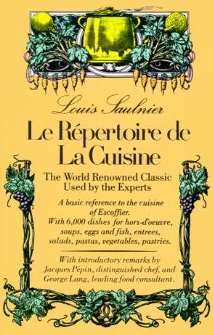Not The Same Fish Everyday
How many times have we heard the old saying "give a person a fish and they eat for a day; teach a person to fish and they can eat forever"? The saying though seems to be missing an important part -- how to cook the fish! If we teach a person to fish and to roast, saute, braise, use a double boiler etc, they'll be much better off. If we teach a person all this and to be handy with a basic recipe, they can cook and create something new. After all, who wants the same fish dish day in and day out?
Teaching people to cook might be the easiest part. If we have anything, we have enough instruction on blogs and food TV to teach the world many different cooking techniques.
Finding basic recipes that give us just enough detail to see what the outcome might be like, but be vague enough to get our innovative juices flowing and enough to create new ideas and bring some new ideas to life is the bigger challenge.
Le Repertoire De La Cuisine
 There is a readily available source of these basic recipes. It was written for another intent, but we can repurpose the information and use the basic recipes to as a base from which to create something new. In 1914, Louis Saulnier wrote the book Le Repetoire de La Cuisine. His intent was to reduce and codify the cuisine of August Esoffier, creating a quick reference for the professional chef for both dishes and menu creation. He created a volume of over 6,000 basic recipes.
There is a readily available source of these basic recipes. It was written for another intent, but we can repurpose the information and use the basic recipes to as a base from which to create something new. In 1914, Louis Saulnier wrote the book Le Repetoire de La Cuisine. His intent was to reduce and codify the cuisine of August Esoffier, creating a quick reference for the professional chef for both dishes and menu creation. He created a volume of over 6,000 basic recipes.
Here is an example of a basic recipe from from Le Repetoire de La Cuisine: "Fricadelles -- Two parts cooked meat mixed with one part mashed potatoes, cooked chopped onions, chopped parsley, egg, season and mix together. Shape and cook. Serve with vegetable puree and highly seasoned sauces."
Recipes like these offer two great things for those who want to create something new. First, it is a little vague (What type of meat? How are the onions cooked? What type of potatoes? How should they be shaped or cooked? etc) so there is plenty of opportunity, with interesting inspiration, to create something new and different. Second, it still has some structure to follow and even some boundaries (should you choose to heed them!) built in. Some limits and concrete scope are good for the innovator, culinary and non-culinary alike.
With a recipe like the one above there are tons of ways to be innovative. We do not need to know what Mr. Escoffier or Mr. Saulnier intended either. We can just use these recipes as the starting point for a new WOW moment. In cooking, inspiration comes from everywhere. Perhaps we want a Christmas feel to our fricadelle -- so turkey and turkey sausage, the mashed potatoes used are sweet potatoes, the onions caramelized. Season with a little nutmeg, salt and pepper, bind with egg. Shape like a patty and sauté or bake. Perhaps season some bread crumbs with some chili powder and brown sugar, dredge the turkey and sweet potato fricadelles and pan-fry them. The basic recipe, with a little inspiration and creativity, is the gift that keeps on giving. A vegan fricadelle? A New Year's fricadelle? A Valentine's fricadelle? Even how it is served -- serve with vegetable puree and highly seasoned sauces -- is another opportunity to innovate the dish and experience of eating fricadelle.
I TwEAT Therefore I am.
If he were alive today, Mr. Saulnier would certainly notice something else about many of the recipes he wrote. Unbeknownst to him, he made many to them twEATable! Many of the recipes are less than 140 characters.
Here is an example of a twEATable salad: "Bismark -- Lettuce Hearts and red cabbage, julliene. Vinaigrette with scraped horseradish."
This recipe is 90 characters -- still plenty of room for added culinary innovation.
Here is a duck dish (with the technical and French words changed so a beginner could use the recipe): "Beaulieu -- Brown Duck parts. Place in tureen, surround with stoned olives, dice tomatoes, shaped potatoes, serve with Madeira sauce."
There is still room for cooking instructions @350 60m or maybe a few hashtags.
Being twEATable gives the opportunity to make creating something new in the kitchen a huge social opportunity. TwEATing the progress of culinary innovation in real time is something that could never have been done before.
Recipes like those in Le Repertoire are a great foundation for innovating in the kitchen. Adding new and different inspiration to these recipes is a certain way to create something new! Don't forget to twEAT your friends about it. Mr. Saulnier surely would!
#twEATable #lerepetoire #culinaryinnovatiion #letscreatesometthingnew!
Have you created something new using a Le Repertoire recipe? Have you ever TwEATed a recipe? Tell us about it in the comments.